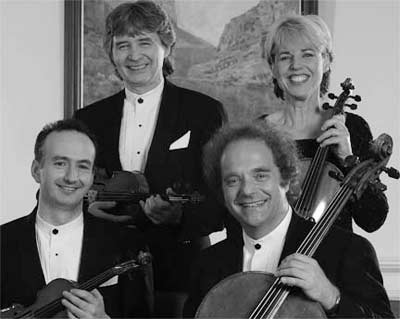 |
Takács String Quartet
presented by Music Toronto |
| December 8, 2005 • Jane Mallet Theatre • Toronto |
|
|
Takács Quartet Warms a Winter Night
by Stanley Fefferman |
| They bring the music to you, this zesty, hearty, playful, exhilarating band of players. The music they chose comes to you on its own too because some themes have been transformed over the years into very popular songs.
The theme of the second movement of the Haydn Quartet in C, Op. 76 No.3 (“Emperor”) was adopted successively as the Austrian national anthem, the “Brotherhood” anthem of Freemasonry, two Protestant hymns, and the infamous “Deutschland, Deutschland über alles”. With new words, this theme is still in service as the current German national anthem.
|
| The Broadway musical Kismet that ran for 583 performances at the Ziegfeld Theatre, from December 1953 to April 1955, gives credit for ‘the music’ to Alexander Borodin, who had been dead for 66 years. The third movement, the “Notturno” that Borodin wrote in 1881 for his String Quartet No. 2 in D contains an ultra-romantic melody reprised as a canon between cello and violin that was borrowed for Kismet and remains in our memory as the tunes “And This is my Beloved”, “Stranger in Paradise”, and “Bangles, Baubles, and Beads.” For his posthumous contribution to this production, Borodin was awarded a Tony in 1954. |
|
 |
|
My point is…? There are two points, actually. First is to note the special pleasure of the very familiar that comes to most of us but rarely in listening to a string quartet. The mind kind of sings along, and that can be very nice and relaxing. The other point is quite the opposite. Familiarity in music often leads to cliché. However, this does not happen with the Takács. They acknowledge the possibility by playing the slow opening bars of Haydn’s first movement in a quasi-schmaltzy parodic style, but they dissolve it into a deeply felt, lovely treatment of the variations on this theme as it moves through successive treatments by the violins’ duo, the cello, and the lastly the viola, played by Geraldine Walther, who seemed so genuinely affected that one thought she was going to disintegrate into a mist of tears.
That didn’t happen. Instead the Takács’ sprightly, witty treatment of the “Menuet” elegantly led by first violinist Edward Dusinberre, and their visibly connected, intuitive approach to the playful “Finale” left them and the audience broadly smiling.
The Borodin Quartet in D features a lot of cello because Borodin himself was a cellist. András Fejér, a founder of the Takács, plays the ‘theme’ with naked emotion, and led the dance of the quartet on surging waves of feeling through the vivacious “Finale”.
Debussy’s Quartet in G minor Op. 10 was the most amorphous piece on the program. Stormy from the start, it brought out a kind of rock group physicality from the players who sawed and squirmed mightily as the music alternately soars, flutters, meanders and bursts towards an ardent, if somewhat tragic conclusion. The second movement has a pizzicato opening led by second violin and founding member Károly Schranz who put down his bow to play this very amusing passage. They ended the recital on a similarly amusing note by playing as an encore the pizzicato movement from Bartók’s String Quartet No. 4.
It has been said that with two Gramophone Awards and a Grammy, the Takács Quartet can do no wrong. Given their technical precision, the warmth and dynamism of approach, and their visible enjoyment of the music they play, I’d go out to hear them play tomorrow, if they would.
|
|
|
|
|
|
|


